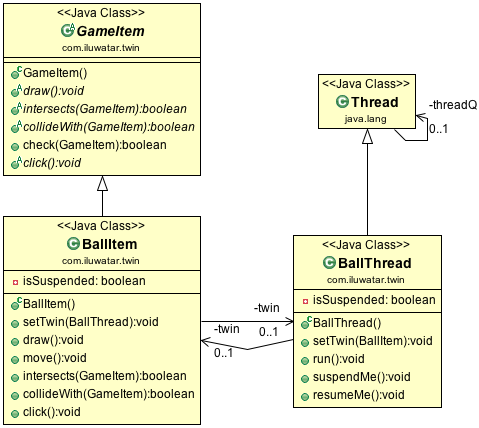Twin
Intent
Twin pattern is a design pattern which provides a standard solution to simulate multiple
inheritance in java
Explanation
Real-world example
Consider a game with a ball that needs features of two types, Game Item, and threads to function
smoothly in the game. We can use two objects, with one object compatible with the first type and
the other compatible with the second type.
The pair of objects together can function as one ball in the game.
In plain words
It provides a way to form two closely coupled sub-classes that can act as a twin class having two ends.
Wikipedia says
In software engineering, the Twin pattern is a software design pattern that allows developers
to model multiple inheritance in programming languages that do not support multiple inheritance.
This pattern avoids many of the problems with multiple inheritance.
Programmatic Example
Take our game ball example from above. Consider we have a game in which the ball needs to be both a GameItem and Thread.
First of all, we have the GameItem class given below and the Thread class.
@Slf4j
public abstract class GameItem {
public void draw() {
LOGGER.info("draw");
doDraw();
}
public abstract void doDraw();
public abstract void click();
}
Then, we have subclasses BallItem and BallThread inheriting them, respectively.
@Slf4j
public class BallItem extends GameItem {
private boolean isSuspended;
@Setter
private BallThread twin;
@Override
public void doDraw() {
LOGGER.info("doDraw");
}
public void move() {
LOGGER.info("move");
}
@Override
public void click() {
isSuspended = !isSuspended;
if (isSuspended) {
twin.suspendMe();
} else {
twin.resumeMe();
}
}
}
@Slf4j
public class BallThread extends Thread {
@Setter
private BallItem twin;
private volatile boolean isSuspended;
private volatile boolean isRunning = true;
/**
* Run the thread.
*/
public void run() {
while (isRunning) {
if (!isSuspended) {
twin.draw();
twin.move();
}
try {
Thread.sleep(250);
} catch (InterruptedException e) {
throw new RuntimeException(e);
}
}
}
public void suspendMe() {
isSuspended = true;
LOGGER.info("Begin to suspend BallThread");
}
public void resumeMe() {
isSuspended = false;
LOGGER.info("Begin to resume BallThread");
}
public void stopMe() {
this.isRunning = false;
this.isSuspended = true;
}
}
Now, when we need the ball, we can instantiate objects from both the BallThread and BallItem as a pair and pass them to its pair object so they can act together as appropriate.
var ballItem = new BallItem();
var ballThread = new BallThread();
ballItem.setTwin(ballThread);
ballThread.setTwin(ballItem);
Class diagram

Applicability
Use the Twin idiom when
- To simulate multiple inheritance in a language that does not support this feature.
- To avoid certain problems of multiple inheritance such as name clashes.